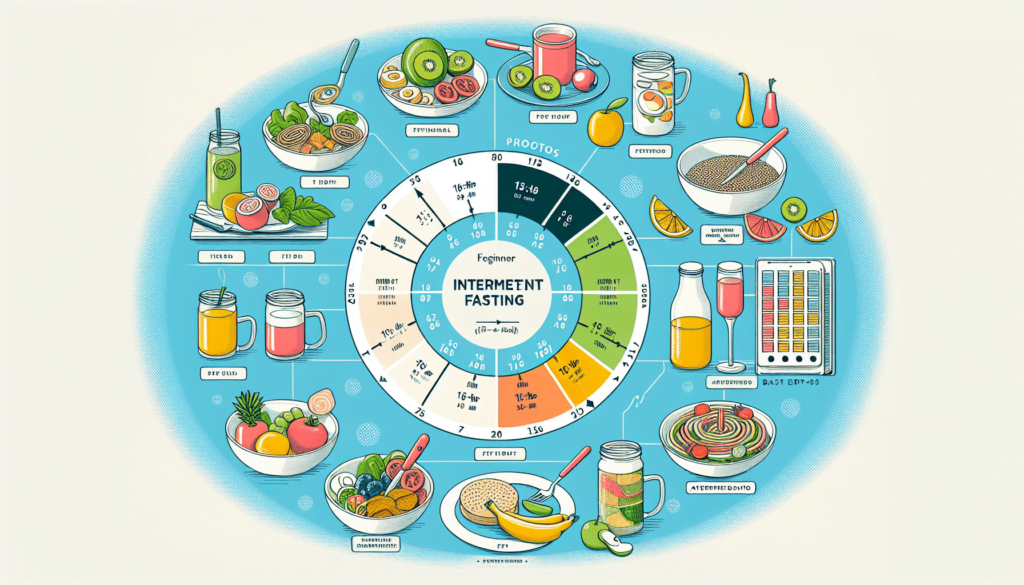So, you’ve heard about this thing called intermittent fasting and you’re curious to know more. Well, you’ve come to the right place. In this beginner’s guide, we’ll break down the various intermittent fasting protocols out there, giving you a clear understanding of how they work and what they entail. Whether you’re looking to shed some extra pounds, improve your overall health, or just want to try something new, this article will equip you with the knowledge you need to embark on your intermittent fasting journey. Get ready to discover a whole new way of approaching your meals and reaping the benefits of intermittent fasting.

What is Intermittent Fasting?
Intermittent fasting is an eating pattern that cycles between periods of fasting and eating. Instead of focusing on what you eat, intermittent fasting places emphasis on when you eat. It has gained popularity in recent years as a way to improve health, promote weight loss, and simplify meal planning.
Definition
Intermittent fasting involves alternating between periods of fasting and eating. During the fasting periods, you abstain from consuming any calories, only allowing yourself to drink water, coffee, or tea. The length of the fasting periods can vary depending on the specific method you choose.
Benefits
There are several potential benefits associated with intermittent fasting. One of the main reasons people choose this eating pattern is for weight loss. By reducing the total number of calories you consume within a day, intermittent fasting can create a calorie deficit, leading to weight loss over time. It can also improve insulin sensitivity, promote cellular repair, and reduce inflammation in the body. Additionally, intermittent fasting may have a positive impact on brain health and longevity.
Popular Intermittent Fasting Methods
There are various intermittent fasting methods to choose from. Each method follows a different fasting and eating schedule, allowing you to find one that aligns with your lifestyle and goals.
16/8 Method
The 16/8 method is one of the most popular and simplest intermittent fasting protocols. It involves fasting for 16 hours and restricting your eating window to 8 hours each day. Most people choose to skip breakfast, start their eating window around lunchtime, and finish their last meal in the evening.
5:2 Diet
The 5:2 diet involves eating normally for five days of the week and restricting your calorie intake to 500-600 calories on the remaining two days. These two fasting days should not be consecutive but spread throughout the week. On fasting days, it is recommended to eat small, nutrient-dense meals.
Alternate-Day Fasting
Alternate-day fasting involves alternating between fasting days and regular eating days. On fasting days, you consume little to no calories, while on regular eating days, you can eat without restrictions. This method may be more challenging for beginners due to the complete fasting days.
Eat-Stop-Eat
The Eat-Stop-Eat method involves a full 24-hour fasting period once or twice a week. For example, you might choose to fast from dinner one day until dinner the next day. During the fasting period, you can consume zero calories, only allowing yourself non-caloric beverages like water, coffee, or tea. On non-fasting days, you eat normally.
Warrior Diet
The Warrior Diet involves fasting during the day and eating one large meal at night. During the fasting period, you can consume small amounts of fruits, vegetables, and protein-rich foods. The main meal is usually consumed within a four-hour window in the evening, allowing you to feel satisfied and satiated.
16/8 Method
The 16/8 method is one of the easiest intermittent fasting protocols to follow. It provides flexibility and is well-suited for beginners.
Explanation
With the 16/8 method, you fast for 16 hours each day and restrict your eating to an 8-hour window. This eating pattern can be adjusted to fit your schedule. For example, you might start your eating window at 12 PM and finish your last meal by 8 PM. During the fasting period, you can consume water, coffee, or tea without any added sugars or creamers.
Benefits
Following the 16/8 method can help reduce daily calorie intake, which may lead to weight loss over time. It can also improve insulin sensitivity and promote fat burning. Additionally, the simplicity of this method makes it easy to incorporate into your daily routine.
Meal Examples
During the eating window, you can consume three meals or distribute your food intake throughout the day. For example, you might have a balanced lunch, a mid-afternoon snack, and a satisfying dinner. It is important to focus on nutrient-dense foods and avoid excessive snacking or overeating.
5:2 Diet
The 5:2 diet offers flexibility while still providing the benefits of intermittent fasting.
Explanation
The 5:2 diet involves eating normally for five days of the week and restricting your calorie intake to 500-600 calories on the remaining two days. These two fasting days should be non-consecutive and can be adjusted to fit your schedule. On fasting days, you can spread your calories throughout the day or have a single nutrient-dense meal.
Benefits
The 5:2 diet can lead to weight loss and improve insulin sensitivity. It may also help reduce inflammation in the body and improve blood lipid profiles. The non-fasting days provide flexibility and allow you to enjoy your favorite foods while still maintaining a calorie deficit.
Meal Examples
On fasting days, it is important to focus on nutrient-dense foods to meet your calorie limit. Examples include a vegetable omelet, grilled chicken salad, or vegetable soup with lean protein. On non-fasting days, you can enjoy your regular meals and incorporate a variety of foods to meet your nutritional needs.

Alternate-Day Fasting
Alternate-day fasting can be more challenging but may provide significant health benefits.
Explanation
Alternate-day fasting involves alternating between fasting days and regular eating days. On fasting days, you restrict your calorie intake to either zero or a minimal amount. You can consume non-caloric beverages and small amounts of low-calorie foods. On regular eating days, you can eat normally without any restrictions.
Benefits
Alternate-day fasting may promote weight loss, improve insulin sensitivity, and reduce oxidative stress. It can also promote autophagy, a cellular cleaning process that may have anti-aging effects. However, this method can be more difficult to maintain long-term, especially for individuals who are new to intermittent fasting.
Meal Examples
On fasting days, you can have small servings of low-calorie foods, such as raw vegetables, fruits, or small portions of lean protein. On regular eating days, you have the freedom to enjoy balanced meals that meet your nutritional needs.
Eat-Stop-Eat
Eat-Stop-Eat involves 24-hour fasting periods once or twice a week.
Explanation
With the Eat-Stop-Eat method, you choose one or two days per week to fast for a full 24 hours. For example, you might fast from dinner one day until dinner the next day. During the fasting period, you can consume zero calories, sticking to water, coffee, or tea. On non-fasting days, you eat as you normally would.
Benefits
Eat-Stop-Eat can support weight loss by creating a significant calorie deficit. It can also improve insulin sensitivity, reduce inflammation, and promote cellular repair. However, fasting for a full 24 hours can be challenging for some individuals, so it is important to listen to your body and adjust the frequency or duration of the fast if needed.
Meal Examples
On non-fasting days, you can eat your regular meals and enjoy a variety of foods. It is crucial to listen to your body’s hunger and fullness cues to ensure you are meeting your nutritional needs. Hydration is also essential during the fasting period to stay hydrated and avoid excessive hunger.
Warrior Diet
The Warrior Diet follows a unique eating pattern that is based on ancient warrior traditions.
Explanation
The Warrior Diet involves fasting during the day and eating one large meal at night. During the fasting period, you can consume small portions of fruits, vegetables, and protein-rich foods. The main meal is typically consumed within a four-hour window in the evening, allowing you to feel satisfied and satiated.
Benefits
The Warrior Diet can promote weight loss, improve insulin sensitivity, and enhance mental clarity. The prolonged fasting period allows the body to utilize stored fat as a source of energy, leading to potential fat loss. However, this method may not be suitable for everyone, especially those with specific dietary needs or medical conditions.
Meal Examples
During the fasting period, you can have small portions of fruits, vegetables, and protein-rich foods, such as a handful of nuts, a boiled egg, or a piece of chicken. The main meal in the evening should consist of a variety of nutrient-dense foods, including lean proteins, whole grains, and ample servings of fruits and vegetables.
Choosing the Right Intermittent Fasting Protocol
When choosing an intermittent fasting protocol, it is essential to consider individual factors and lifestyle preferences.
Considerations
Consider factors such as your current health status, medical conditions, and any medications you may be taking. Some protocols may not be suitable for individuals with certain conditions, such as diabetes or eating disorders. It is crucial to consult with a healthcare professional before starting any intermittent fasting protocol.
Lifestyle Factors
Evaluate your daily schedule and lifestyle to find an intermittent fasting method that aligns with your routine. Consider factors such as your work schedule, social commitments, and overall eating habits. Choosing a method that fits seamlessly into your life will increase your chances of sticking to the fasting protocol long-term.
Getting Started with Intermittent Fasting
Once you have chosen an intermittent fasting protocol, there are a few key steps to help you get started and maximize your success.
Consulting a Healthcare Professional
Before starting any intermittent fasting protocol, it is essential to consult with a healthcare professional. They can assess your individual health needs and provide guidance on potential risks or considerations specific to your situation. They can also help monitor your progress and adjust the fasting protocol if needed.
Setting Realistic Goals
Setting realistic goals is crucial for a successful intermittent fasting journey. Consider what you hope to achieve, whether it’s weight loss, improved energy levels, or better overall health. Remember that intermittent fasting is not a quick fix but rather a long-term eating pattern that requires commitment and consistency.
Managing Hunger and Cravings
During the fasting periods, you may experience hunger and cravings, especially when first starting out. It is important to listen to your body and recognize the difference between true hunger and emotional or habitual eating. Staying hydrated, keeping busy, and consuming foods rich in fiber and protein during the eating window can help manage hunger and cravings.
Monitoring Progress and Adjusting
Monitoring your progress and making adjustments along the way is essential to ensure you are on track and making the most out of intermittent fasting.
Tracking Weight and Measurements
Regularly tracking your weight and measurements can provide insight into your progress. However, it is important to remember that weight loss may not be the sole indicator of improvement. Pay attention to how you feel, your energy levels, and any changes in body composition for a more comprehensive picture of your health.
Modifying the Fasting Schedule
As you become more comfortable with intermittent fasting, you may consider modifying your fasting schedule to better suit your needs. You can experiment with the length of the fasting window, the frequency of fasting days, or even incorporating other dietary approaches, such as caloric cycling. Remember to listen to your body and make adjustments that align with your goals and preferences.
In conclusion, intermittent fasting offers a flexible and effective approach to improve health, promote weight loss, and simplify meal planning. With various methods to choose from, you can find one that suits your lifestyle and goals. Remember to consult with a healthcare professional, set realistic goals, and listen to your body as you embark on your intermittent fasting journey. Happy fasting!








